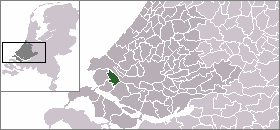Brielle
- This article is about a city in the Netherlands. There is also a Brielle, New Jersey in the United States of America.
Brielle | |
|---|---|
Municipality | |
 | |
| Country | Netherlands |
| Province | South Holland |
| Area (2006) | |
| • Total | 31.12 km2 (12.02 sq mi) |
| • Land | 27.49 km2 (10.61 sq mi) |
| • Water | 3.63 km2 (1.40 sq mi) |
| Population | |
| • Total | 15,922 |
| • Density | 579/km2 (1,500/sq mi) |
| Source: CBS, Statline. | |
| Time zone | UTC+1 (CET) |
| • Summer (DST) | UTC+2 (CEST) |
| Website | www.brielle.nl |

![]() Brielle, also called Den Briel (Brill in English) is a town and municipality in the western Netherlands, in the province of South Holland, on the north side of the island of Voorne, at the mouth of the New Maas. The municipality covers an area of 31.12 km² (12.02 mile²) of which 3.63 km² (1.40 mile²) is water. In 2004 its population was 15,948.
Brielle, also called Den Briel (Brill in English) is a town and municipality in the western Netherlands, in the province of South Holland, on the north side of the island of Voorne, at the mouth of the New Maas. The municipality covers an area of 31.12 km² (12.02 mile²) of which 3.63 km² (1.40 mile²) is water. In 2004 its population was 15,948.
The municipality of Brielle also includes the communities Vierpolders, and Zwartewaal.
In 1967, the Queenborough (England) and Brielle (Holland) twinning project was established.
History
Brielle is a very old, fortified town. Its name is derived from the Celtic word brogilo (meaning "closed area" or "hunting grounds"). The oldest writings about Brielle indicate that the current location is the "new" Brielle. Den ouden Briel (Old Brill) must have been situated somewhere else on the Voorne-Putten Island. It received city rights in 1306. The city was for a long time the seat of the Count of Voorne, until this fiefdom was added to Holland in 1371. It had its own harbour and traded with the countries around the Baltic Sea. Brielle even had its own trading colony in Sweden.
During the Eighty Years' War between the Netherlands and Spain, the Capture of Brielle on April 1, 1572, by Protestant rebels, the Watergeuzen, marked a turning point in the conflict, as many towns in Holland then began to support William of Orange against the Spanish Duke Fernando Álvarez de Toledo, 3rd Duke of Alba who was sent to pacify The Netherlands. This event is still celebrated each year on April 1 and the night before (known as Chalk Night (kalknacht) when the city is defaced with chalk - and now also white paint). Dutch students are taught a short rime to remember this fact:
- "Op 1 april verloor Alva zijn bril" translating into "On 1st of April, Alva lost his brill",
("bril" is the dutch word for "glasses". The same rhyme continues with the line "Op april zes verloor Alva zijn fles" "On April 6th Alva lost his bottle" in which the word "Fles" stands for the town of Vlissingen, which was the next town to be caught by the dutch rebels.)
During this battle the Protestant rebels killed the catholic Martyrs of Gorkum and Brielle has become a pilgrimage location since then.
In August 1585, Brielle was one of the four Dutch towns that became an English possession by the Treaty of Nonsuch when Queen Elizabeth I received it as security of payment for 5000 soldiers used by the Dutch in their struggle against the Spanish. In 1616, these cities returned to the Netherlands.
Attractions
- The city is famed for its city fortifications complete with city moat.
- St. Catharijnekerk (Saint Catherine Church) - this church was intended to become the largest church in the Netherlands but never completed. In 1417 construction began but in 1456 it burnt down and in 1482 funding ran out and construction stopped. Only the nave and the 57 meter blunt tower were completed.
- There are many historic buildings in the centre, among which are the Arsenal from 1708 (now a library) and Old City Hall (now a museum).
- Brielse Lake (formerly Brielse Maas) - a popular area for water sports and recreation.
Born in Brielle
- Hendrik Speuy (1575) - organist and composer, contemporary of Jan Pieterszoon Sweelinck
- Maarten Harpertszoon Tromp (1598) - Lieutenant-Admiral and supreme commander of the Dutch Navy
- Witte Corneliszoon de With (1599) - Vice-Admiral and supreme commander of the Dutch Navy
- Philips van Almonde (1644) - Lieutenant Admiral of the Dutch Navy
- Toon Tellegen (1941) - writer, known for his children books
- Rob Romein (1949) - businessman, co-founder of Tulip Computers
External links
- Official Website (some pages in English)
- http://www.plattegronden.nl/gemeentebrielle



